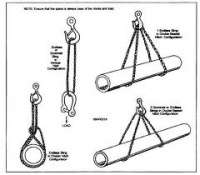Difference between revisions of "Slings"
(Created page with "Category: Loading and Unloading Equipment{{Knoppen}} <noinclude><!------------------------------------------------ * READ THIS FIRST * Only edit this page if you can imp...") |
PurplePen19 (talk | contribs) |
||
| Line 7: | Line 7: | ||
* Please start editing this page after the /noinclude | * Please start editing this page after the /noinclude | ||
* -------------------------------------------------></noinclude> | * -------------------------------------------------></noinclude> | ||
This | [[File:Slings_1.jpg|thumb|200px|right|Slings]] | ||
'''Slings''' are commonly used in constructions to hold and lift objects. | |||
==Common Types== | |||
===Fiber Line Slings=== | |||
Fiber line slings offer the advantage of flexibility and protection of finished material. At the same time, fiber-line slings are not as strong as wire-rope or chain slings. In addition, fiber-line slings are more likely to be damaged in the event of sharp edges on the material being hoisted than are wire-rope or chain slings. | |||
===Endless Sling=== | |||
This is the most common type and usually referred to as a SLING, can be made by splicing together the ends of an endless sling is easy to handle, and you can use it in several different ways to lift loads. Frequently, it is used as a choker hitch. To form a choker hitch, cast the sling under the load to be lifted and insert one loop through the other and over the hoisting hook. | |||
===Single Sling=== | |||
A SINGLE-LEG SLING, commonly referred to as a STRAP, can be constructed by forming a spliced eye in each end of a piece of fiber line or wire rope.Sometimes the ends of a piece of wire rope are spliced into eyes around thimbles, and one eye is fastened to a hook with a shackle. With this arrangement, the shackle and hook are removable.A single-leg sling may be used as a choker hitch(fig. 1-11) in hoisting by passing one eye through the piece of fiber line or wire rope to form an endless loop. | |||
==Videos== | |||
<youtube>_MLt57fleYM</youtube> | |||
Latest revision as of 19:29, 5 September 2013
Slings are commonly used in constructions to hold and lift objects.
Common Types
Fiber Line Slings
Fiber line slings offer the advantage of flexibility and protection of finished material. At the same time, fiber-line slings are not as strong as wire-rope or chain slings. In addition, fiber-line slings are more likely to be damaged in the event of sharp edges on the material being hoisted than are wire-rope or chain slings.
Endless Sling
This is the most common type and usually referred to as a SLING, can be made by splicing together the ends of an endless sling is easy to handle, and you can use it in several different ways to lift loads. Frequently, it is used as a choker hitch. To form a choker hitch, cast the sling under the load to be lifted and insert one loop through the other and over the hoisting hook.
Single Sling
A SINGLE-LEG SLING, commonly referred to as a STRAP, can be constructed by forming a spliced eye in each end of a piece of fiber line or wire rope.Sometimes the ends of a piece of wire rope are spliced into eyes around thimbles, and one eye is fastened to a hook with a shackle. With this arrangement, the shackle and hook are removable.A single-leg sling may be used as a choker hitch(fig. 1-11) in hoisting by passing one eye through the piece of fiber line or wire rope to form an endless loop.
Videos
